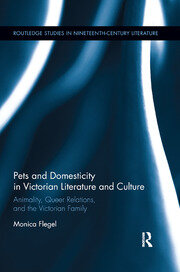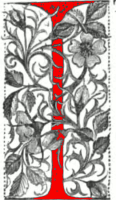This review is reproduced here by kind permission of the online journal Review 19, where it was first published. The original text has been reformatted and illustrated for the Victorian Web by Nigel Finch. Click on the images for larger pictures.


n recent years, the literary representation of animals has drawn the interest of scholars such as Colleen Boggs, Tess Cosslet, Harriet Ritvo, Ivan Kreilkamp, Kathleen Kete, and the many contributors to Victorian Animal Dreams: Representation of Animals in Victorian Literature and Culture (2007), a collection of essays edited by Deborah Denenholz Morse and Martin A. Danahay. Building upon their studies of children's books about animals, animal autobiographies, anthropomorphism and its obverse, representational strategies, and histories of animals, this book makes a crucial contribution to animal studies, narrative studies, and Victorian literary history.
Monica Flegel shows how the Victorians turned pets into people. In this deeply researched, historicized, and theorized study, she probes Victorian novels in which pets stand in for members of the family, whether as children, siblings, or companions, or as romantic and/or sexual partners. Studies of relations between humans and animals normally argue that such relations are peculiar to specific times and locations. While pursuing this argument, Flegel also applies queer theory, which resists the normative pull of heterosociality. She aims to show, then, how "narratives of animal/human companionship both regulate and defy boundaries of species, gender, sexuality, and class in that complicated structure we know as the family" (15).
Among the many theorists Flegel draws upon, Lee Edelman looms large, particularly in his concept of "reproductive futurism." According to Edelman's No Future: Queer Theory and the Death Drive (2004), normative domesticity assumes that "the Child" stands in for the future, so that "we must all be on the side of 'The Child.'" Those who accept that premise hold that only families able to produce biological children are legitimate (8). But this way of thinking, Edelman argues, excludes most queer families. Flegel takes her cue from this point. Even while showing how fictional pets were used to bolster confidence in conventional families and the plots that celebrate them, she also argues that the intensity of human-animal bonds in a host of Victorian novels offers an often deeply satisfying alternative to this limited construction of domesticity.
Her chapters highlight the roles pets play in relation to the conventional Victorian heterosexual family, with careful attention to class and gender. The titles are narratives in themselves. Chapter 1, "Love Me, Love My Dog: The Role of the Pet in Rituals of Courtship and Romance," defines a kind of substitution that recurs throughout this study. In fresh readings of well known novels such as George Eliot's Middlemarch and Anne Brontë's The Tenant of Wildfell Hall as well as of lesser known novels, she shows how romance plots use pets and then discard them. Pets, we learn, can serve as surrogates, vehicles for hidden emotion, or judges of an individual's appropriateness as a future partner. Once a character learns how to cherish and care for a pet--in preparation for conjugal and maternal obligations--she is ready for the proper objects of affection. Yet ironically, she demonstrates her readiness for heterosexual romance by first of all shifting all her affection to a human being, leaving the pet behind and thus pushing it out of the plot. Animals and animal imagery can also signal whether or not a female character is a desirable partner. In other words, if a Victorian female character is seeking a husband, she should neither own a lapdog nor invite the label "kittenish." Either would doom her to charges of narcissism.
In chapter 2, "Becoming Crazy Cat Lady: Women and their Pets in the Domestic Circle," and Chapter 3, "Pets and Patriarchy: Bachelors, Villains, and Their Animal Companions," Flegel challenges the Victorian dismissal of elderly bachelors as well as spinsters. Chapter 2 shows that spinsters and their pets, especially cats, were stigmatized in all sorts of ways, especially when they were content without husbands or children. Such women, including woman scholars, were thought to exemplify female "failure." Mining magazine articles and little known novels that represent women as oversexed, undersexed, adorable, anti-social, self-absorbed, fanatical, witches, and wantons, Flegel documents the overwhelmingly diverse attacks on (and occasionally defenses of) single women attached to animals.
Bachelors fared just slightly better. Though Flegel convincingly shows that they too were represented as failures, their selfishness, ineptitude, or villainy (think Bill Sykes) usually highlighted by contrast the quiet heroism of normative masculinity.
Animal subjectivity is the chief topic of Chapter 4, "Household Pets, Waifs, and Strays: Children and Animals Inside and Outside the Victorian Home" and of the conclusion. Carefully analyzing the equation of pets to children in multiple novels, Flegel shows how much this equation endangered both. Their shared dependency made both groups vulnerable to abuse, exploitation, and violence. Exposing hierarchies and abuses of power within the family and the potential for escape from the family, waifs and strays inhabited a uniquely liminal space. Since these novels also show how often "pets" of any species, including orphans and outcast children, were callously sacrificed to protect other interests, Flegel argues that these novels expose the hypocrisy of "reproductive futurism."
In her delightful conclusion, Flegel turns to stories of animal families. Though many of them are disrupted by humans, a few exemplify animal-centric or more precisely "cat-centric" (194) domesticity: animal relations just beyond our grasp and at least momentarily free of human intervention.
Flegel's book is an important contribution to the growing number of literary studies that triangulate narrative theory, social history, and inter-species engagements. Inevitably and often with a sense of regret and resignation, Flegel and other scholars who share her interests recognize the impossibility of writing about the history and representation of animals themselves. But their relation to human beings is a matter of growing salience. In recent decades scholars have taught themselves to read against the dominant grain of fiction by studying convoluted ways in which language, figures, plots, and ideological assumptions inscribe Victorian preoccupations with gender, sexual identity, class, race, and other differences. While joining those who study animals in fiction, Flegel sheds fresh light on the literary politics of speciesism.
Besides her insightful, instructive analyses of the critical role that pets play in domestic plots and family structures, she also recovers a wealth of overlooked novels. These she returns to literary history by means of her overarching arguments about love, life stages, and the widespread queerness in human and animal relationships: queerness that complicates the normative structure of "the family."
Ultimately, this study shows how Victorian fiction critiques the reproductive imperative. In addition, Flegel provides a moving, convincing argument about the depth of feeling that real and imagined Victorians had for their pets. As she presents it, this feeling powerfully reminds us that the value of immediate, intimate relationships between humans and animals as well as between humans themselves is better measured in the moment than hoarded for unknowable features.
Links to Related Material
References
(Book under review) Flegel, Monica. Pets and Domesticity in Victorian Literature and Culture: Animality, Queer Relations, and the Victorian Family. London: Routledge, 2015.
Last modified 9 July 2023